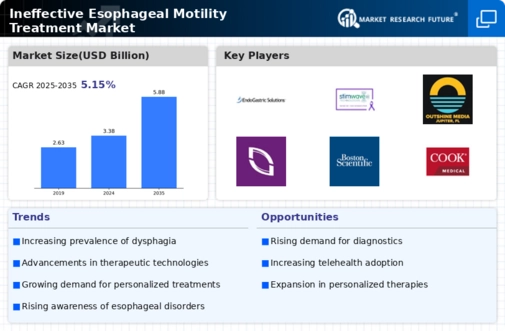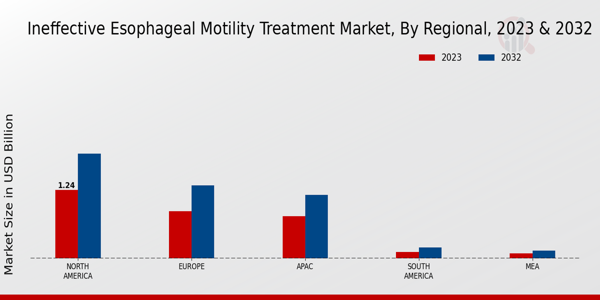The Ineffective Esophageal Motility Treatment Market is driven by an increasing prevalence of esophageal disorders and a growing awareness of gastrointestinal health. As populations age and lifestyle factors contribute to digestive issues, the demand for effective treatment options continues to rise. Additionally, advancements in medical technology and therapies have led to innovative solutions aimed at improving esophageal motility. This has captured the attention of healthcare providers and patients alike, fostering a market environment focused on enhancing the quality of life for individuals suffering from these conditions.
There are significant opportunities to be explored within this market, particularly in developing targeted therapies and personalized medicine approaches.Research into the underlying causes of ineffective esophageal motility is paving the way for more effective and tailored treatments that could lead to improved patient outcomes. Furthermore, the integration of digital health technologies and telemedicine presents avenues for better patient monitoring and adherence to treatment protocols. These advancements could support healthcare professionals in managing and treating esophageal motility disorders more effectively, enhancing the overall treatment landscape.
Recent trends in the Ineffective Esophageal Motility Treatment Market include a shift towards minimally invasive procedures and increased collaboration between pharmaceutical companies and research institutions.This collaboration is facilitating the development of novel therapeutic agents and improving diagnostic techniques, ultimately leading to better management of esophageal conditions. Additionally, growing investment in healthcare infrastructure and awareness campaigns is expected to further stimulate the market as patients become more informed about their conditions and available treatment options.
Overall, the interplay of these factors is shaping a dynamic landscape in the treatment of ineffective esophageal motility, creating opportunities for growth and innovation in this critical area of healthcare.
Ineffective Esophageal Motility Treatment Market Driver
Increasing Prevalence of Esophageal Disorders
The Ineffective Esophageal Motility Treatment Market Industry is witnessing significant growth due to the rising prevalence of esophageal disorders such as achalasia, esophageal spasms, and other motility disorders. This increase is attributed to various factors including lifestyle changes, dietary habits, and a growing aging population more susceptible to gastrointestinal conditions.
With advancements in diagnostic techniques, more patients are being identified and diagnosed with ineffective esophageal motility issues, leading to an uptick in demand for effective treatment solutions.Furthermore, as awareness about esophageal motility disorders grows among healthcare professionals and patients alike, there is a surge in the need for innovative therapies and management options.
The market is thus driven by the urgency to address the rising number of patients seeking treatment, fostering an environment ripe for expansion and innovation in therapeutic offerings. As the industry progresses, developing tailored treatment plans and enhancing patient engagement will become critical factors influencing market dynamics, compelling manufacturers to invest in research and development.The expected rise in market value reinforces the notion that investments in addressing these conditions will be pivotal for both patients and healthcare providers.
Advancements in Treatment Technologies
Technological advancements in the treatment of ineffective esophageal motility are a crucial driver of growth in the Ineffective Esophageal Motility Treatment Market Industry. Emerging therapies, including minimally invasive surgical techniques and novel pharmacological agents, offer enhanced treatment outcomes and improved patient comfort. These advancements not only provide solutions to previously challenging conditions but also enable healthcare providers to offer a wider range of therapeutic options that cater to individual patient needs.Additionally, the integration of telemedicine and digital health solutions in managing esophageal disorders facilitates better monitoring and follow-up care, further driving the market.
Growing Awareness About Esophageal Health
Public awareness campaigns aimed at educating individuals about esophageal health are significantly contributing to the growth of the Ineffective Esophageal Motility Treatment Market Industry. Increased knowledge about symptoms and risks associated with esophageal motility disorders encourages individuals to seek timely medical advice and treatment. As healthcare providers focus on preventive care and early intervention, the market is poised to expand, fueled by proactive patient engagement in managing their health.
Ineffective Esophageal Motility Treatment Market Segment Insight
The increasing prevalence of esophageal motility disorders, coupled with advancements in therapeutic techniques, suggests a burgeoning landscape for treatment options in the realm of ineffective esophageal motility.
U.S. National Institutes of Health












